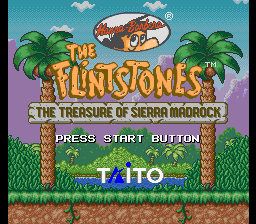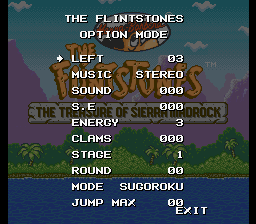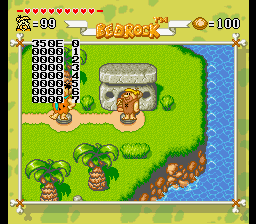The Flintstones: The Treasure of Sierra Madrock
| The Flintstones: The Treasure of Sierra Madrock |
|---|
|
Developer: Taito
|
| To do: * Document the prototype
|
The Flintstones: The Treasure of Sierra Madrock is yet another in a series of corny rock-themed puns.
Contents
Developer Message
At 0x6D6B2 is a version number and a copyright message featuring Kennosuke Suemura's name, who is one of the game's composers.
Ver1.27 Copyright K.Suemura
Anti-Piracy
| Normal | Pirated |
|---|---|
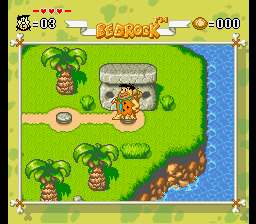 |
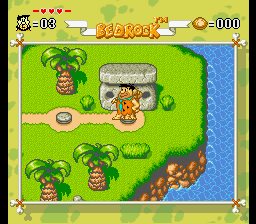 |
The game uses the SRAM area for various portions of gameplay. The game normally does not have SRAM, so this memory region gets updated properly and gameplay runs normally. If the game happens to have SRAM added (as easily observed in a cartridge copier), the game will slow down many core mechanics of gameplay to about half the original speed, which includes Fred and Barney's movement speed. However, the timer on each level will still count down normally, making the game much harder if not outright impossible to complete. This even affects the map screen and the results screen at the end of each stage, with the latter being out of sync to the music as a result. Although the game itself does not contain any innate SRAM checks, the usage of the SRAM region this way ends up creating an unintentional anti-piracy protection. This proved problematic when the game's prototype first came out, as it was dumped with SRAM installed.
Cheat Mode
Using the Pro Action Replay code 85B7E780 (US version) enables a debug/cheat mode of sorts. Each section below assumes that this mode is active.
Options Menu
When the "press start button" text appears, hold down L + R and press Up, X, Down, B, Left, Y, Right, and A. A sound will play to confirm you've entered the code correctly. Now the options menu is expanded with several new options.
Ingame buttons
During the game, press any of the following on controller 2:
- A: enters/exits the current space without ending your turn.
- B: automatically takes you to the area or stage (if you're already at stage 5, you'll just end up at stage 5 again).
- R: start the race against Rockhead.
- Start: toggles unlimited time (regular stages only).
Pause buttons
Also, there are 3 button sequences for controller 1 which can be activated while the game is paused (they must be done in this order). The currently playing song/sound will change to indicate that the code was input successfully.
- Hold Down, hold Right, release Down, press A: unlimited time, 99 lives, 100 clams, maximum hearts.
- Press Right, hold Down, hold Right, press A: temporary invincibility.
- Hold Down, hold Left, release Down, press B: effect unknown.
- also sets bit 0004 of $1F79 (effect unknown).
Debug display
When bit 0002 of $1F79 is set, this display appears on the map screen, showing the values of the eight 16-bit words between $1F7B and $1F89. What each one represents is unknown, though the first one always seems to be set to 350E when leaving a stage.
There is no apparent way to enable this feature without manually editing RAM.
The Flintstones series
| |
|---|---|
| Arcade | Fred Flintstone's Memory Match |
| NES | The Rescue of Dino and Hoppy • The Surprise at Dinosaur Peak! |
| SNES | The Treasure of Sierra Madrock • The Flintstones (Prototype) |
| Game Boy (Color) | King Rock Treasure Island • The Flintstones • Burgertime in Bedrock |
| Sega Master System | The Flintstones |
| Genesis | The Flintstones (Taito) |
| Game Boy Advance | Big Trouble in Bedrock |
| Windows | Bedrock Bowling |
| PlayStation | Bedrock Bowling |
| PlayStation 2 | Bedrock Racing |
| Adobe Shockwave | Fred Rocks |
| See Also | |
| The Jetsons • Cartoon Network | |
- Pages missing developer references
- Games developed by Taito
- Pages missing publisher references
- Games published by Taito
- SNES games
- Pages missing date references
- Games released in 1994
- Games released in August
- Games released on August 12
- Games released in March
- Games released in June
- Games released on June 23
- Games with hidden development-related text
- Games with debugging functions
- Games with hidden sound tests
- Games with hidden level selects
- Games with anti-piracy methods
- To do
- Flintstones series
Cleanup > Pages missing date references
Cleanup > Pages missing developer references
Cleanup > Pages missing publisher references
Cleanup > To do
Games > Games by content > Games with anti-piracy methods
Games > Games by content > Games with debugging functions
Games > Games by content > Games with hidden development-related text
Games > Games by content > Games with hidden level selects
Games > Games by content > Games with hidden sound tests
Games > Games by developer
Games > Games by developer > Games developed by Square Enix > Games developed by Taito
Games > Games by platform > SNES games
Games > Games by publisher
Games > Games by publisher > Games published by Square Enix > Games published by Taito
Games > Games by release date > Games released in 1994
Games > Games by release date > Games released in August
Games > Games by release date > Games released in August > Games released on August 12
Games > Games by release date > Games released in June
Games > Games by release date > Games released in June > Games released on June 23
Games > Games by release date > Games released in March
Games > Games by series > Flintstones series
